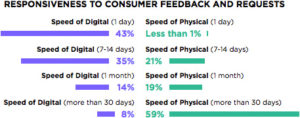One of the easiest ways to get started with Agile Marketing is to use Scrum to manage the production of Content. Agile was designed to help improve the production of software code; it makes sense that it could be useful to manage the production of Content. I see many organizations taking this approach, using Scrum to manage Content.
The question is: can Agile be used in other areas of marketing? I think the answer is YES. Here are a few other areas where the use of Agile techniques can be applied to marketing:
Planning and Executing Events, Including Product Launches
The application of Agile to planning and executing events seems like an obvious fit to me. That’s why I’m surprised that marketing event planners often resist Agile Marketing. Their reasoning is that many events require that they put down a deposit and pick a date for an event 6-12 months in advance, and they view Agile as something that is limited to 2-3 week Sprints, with each Sprint totally independent of the one before it. To me, this is like someone at Microsoft refusing to adopt Agile because they ship a new version of Windows or Office every couple of years.
Agile can easily adapt to tasks that require more than a single Sprint’s worth of work through the concept of an Epic. To me, the value of using Agile, particularly Scrum, to manage events, including product launches, is the emphasis that it puts on communication. Particularly as you approach the date of an event, a daily standup is critical. In addition, Scrum ensures that responsibilities and ownership are clear, and that if someone is not making progress on their assigned tasks, that roadblocks or a failure to perform are discovered early, before they derail the event.
Exploring New Markets
At a company I’m working with, we’re looking at potentially entering a new market. This requires not only traditional market research, but also reaching out to a number of people who are potential customers for the new service. As this research requires close communication and cooperation among several people, all of whom have “day jobs”, I’m planning to use a modified version of Scrum, with bi-weekly stand ups and two week Sprints, to manage the process.
We can also use the concept of a Sprint Planning session to prioritize our tasks, ensuring that we only commit to as much work as we can realistically get done in two weeks time, and observing our progress over time.
Product Management
Product management often encompasses a very broad set of responsibilities. Here, I’m referring specifically to that aspect of Product Management where the product manager is the Product Owner. If the product manager is working with a development team who is also practicing Agile, it can be helpful if he also practices Agile, particularly if he has responsibility for writing User Stories.
It is very important that the product manager to stay ahead of the development team, making sure that he has a backlog of fully fleshed out User Stories, ready for each Sprint Planning Session. If this is not the case, product management can become a bottle neck, slowing down the development team because they don’t have complete and detailed User Stories going into each Sprint.
If the Product Manager is a one-man band, this may not be necessary, but if, as often is the case, product management is a team of several individuals, Agile can provide an excellent way to keep the team on track and facilitate communication.
Launching Advertising Campaigns
Here’s another group that I find often resists Agile Marketing. They sometimes say that they have to plan out media buys months in advance and that it isn’t realistic to practice the quick iterations of Agile Marketing. Really? I’m not an expert in advertising by any means, but in this world of Ad Exchanges and real-time bidding of online ads, not to mention tools like Google AdWords and Google AdSense, is it really necessary to plan out media buys months in advance? Unless you’re buying SuperBowl or other big event television ads, whose effectiveness I often question, I’m not convinced that this precludes you from practicing Agile Marketing.
In particular, I wish more ad campaigns had well-defined success metrics relevant to the business, and that the advertisers iterated on ads until they found the best formula for achieving those metrics. I still see way too many ad campaigns that measure what Eric Ries calls vanity metrics rather than actionable metrics. Things like impressions, brand recall, ad recall, etc I consider to be vanity metrics. As a CEO, those kinds of metrics drive me crazy. I want to know how much more we sold, or how many sales qualified leads we added to the pipeline.
One more comment about the impact of Agile Marketing on Advertising: if you look at the original Agile Marketing Manifesto, you’ll see two Values that are very relevant to advertising:
Value 3 – Adaptive and Iterative campaigns over Big-Bang Campaigns
Value 7 – Many Small Experiments Over a Few Large Bets
I would love to see more advertising campaigns following these precepts.
Lead Generation
There are probably other areas of marketing where Agile can be applied, but I’ll make this the last one in this post. I like to see lead generation specialists following the Agile values of validated learning and iteration. I see way too many lead generation efforts celebrating the number of attendees at a webinar or the number of click throughs of an ad campaign, without any context or comparison. If you get 60 people to attend a webinar, is that good or bad? Of course it depends, and the best way to quantify “it depends” is to show progress over time. The best way to make progress over time is to experiment and to try out new approaches.
What kind of experiments are you doing in your lead generation program? Do you train your inside sales people to experiment with multiple scripts, to determine what works and what doesn’t? How have you validated that your lead generation program is as efficient as possible?
Where are you using Agile Marketing? Do you think it applies to areas beyond Content Marketing? I’d love to hear about your experience.





Yes! Absolutely Agile Marketing can be used for other purposes beyond content. We use a ScrumBan approach to keep track of our many millions of marketing projects – from email campaigns to PPC, sales trainings, new product launches, events, and much more! We love it!
We first adopted Agile Marketing when we were getting ready to launch our new website. We started on the right track when we decided to create user stories to define what the new website should do for our prospects, customers and internal stakeholders. The developer used scrum as part of their process. It made sense we would also go agile to deliver our part of the project. In hindsight I can comfortably say we would not have made our deadline without agile. Simply having a clear overview of all the stories and tasks that needed closing, progress of tasks and a clear goal to complete all stories before the end of the sprint was instrumental in launching our new website, on time. The project took 5 months in total. We went agile ourselves the last 10 weeks of the project and have continued to work agile every since. Our marketing communications and corporate communications departments will follow our example and go agile too. It’s important to be aligned.
Saskia, that’s great to hear. I’d love to hear how your marcom and corpcom departments do as they transition to Agile.
Pingback: Is Agile Marketing Only Useful for Managing Con...